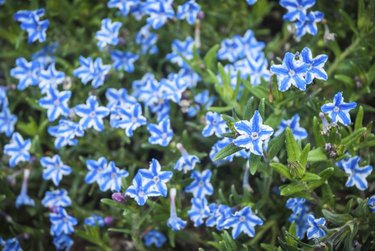
Providing a carpet of blue flowers from late spring through early summer, Lithodora diffusa works well as a ground cover plant. An evergreen that grows in U.S. Department of Agriculture plant hardiness zones 7a through 9b, lithodora is a true blue garden flower. Dark green leaves provide a background that makes the blooms stand out, and the leaves shade the ground, discouraging weed growth. Lithodora grows about 24 inches wide and 3 to 4 inches tall in sunny spots, or up to 12 inches when grown in partial shade.
Growing Sites
Video of the Day
Sunny sites with well-drained, acidic soil provide the best growing conditions for lithodora. This perennial grows in partial shade but can grow leggy and unattractive; crowding plants can also make them tall and spindly. For the best growth and flowering, grow lithodora in areas that receive six or more hours of sunlight per day, in soil with a pH between 5.6 and 6.5. Lithodora doesn't thrive in alkaline or poorly drained soil, such as heavy clay. Space lithodora plants 18 to 24 inches apart.
Video of the Day
Watering and Fertilizing Lithodora
Established lithodora plants tolerate drought and rarely need fertilizer. Water established plants when the soil is dry to a depth of 1 inch, and water newly planted lithodora when the soil surface is dry during the first growing season. Slowly apply water until it begins to puddle, then stop. Dark green lithodora plants don't need fertilizer, but if the leaves turn greenish yellow, apply a fertilizer for plants that grow in acidic soil. Dilute a 30-10-10 fertilizer formulated for acid-loving plants at a rate of 1/2 teaspoon per 1 gallon of water, and apply the solution until it forms a puddle, then stop. Apply the fertilizer solution every two weeks, beginning in late winter or early spring when new growth appears and stopping when the leaves turn green. You can replace water with fertilizer solution if the plant needs watering.
Pruning Plants
Pruning lithodora removes frost-damaged foliage and helps prevent plants from growing leggy. Blackened leaves and stems are a sign of frost damage on lithodora. Prune damaged foliage after the average final frost date in your area. Wipe pruning shear blades with a cloth soaked in rubbing alcohol to sterilize them, and prune below damaged areas where the stems are fully green, at the point where they join the rest of the plant. To encourage bushy, dense growth on spindly plants, prune lithodora after flowering, removing half the length of the stem just above the nearest bud. Sterilize the pruning shears when you've finished pruning.
Growing Cultivars
Lithodora cultivars provide a range of attractive flower patterns and colors. Lithodora "White Star" (Lithodora diffusa "White Star," USDA zones 7a through 9b) features blooms with white, star centers surrounded by stripes of intense blue. "Grace Ward" (Lithodora diffusa "Grace Ward," USDA zones 6 through 9) bears deep blue flowers and grows 3 to 4 feet wide. "Heavenly Blue" (Lithodora diffusa "Heavenly Blue," USDA zones 5 through 9) provides blooms that are royal blue, grows 1 to 1 1/2 feet wide and tolerates light foot traffic.
- ZipcodeZoo: Lithodora Diffusa
- Ed Hume Seeds: Lithodora -- A Colorful Blue Flowering Ground Cover
- Plant Lust: Lithodora Diffusa "White Star"
- Monrovia: "Grace Ward" Lithodora
- Perennials.com: Lithodora Diffusa "Heavenly Blue"
- University of Ilinois Extension: Understanding Acid-Loving Plants and Soil pH